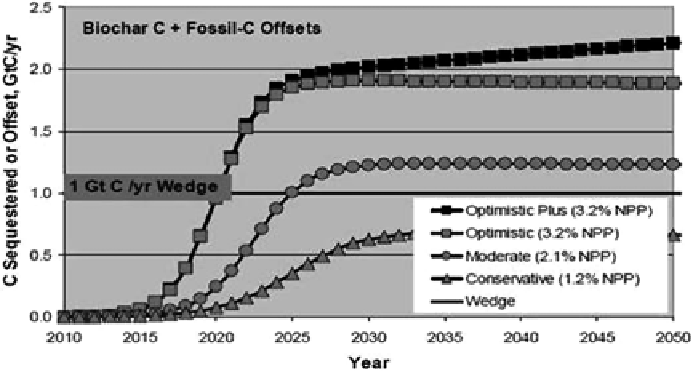Agriculture Reference
In-Depth Information
Fig. 13.7
Projection of carbon offset by biochar technology by 2050
approaches are being identifi ed for widespread
introduction of biochar in these countries.
The optimistic scenario in Fig.
13.7
shows
that the use of biochar can sequester 2.2 gigatons
of carbon annually by 2050. In agricultural soils,
biochar has been experimentally shown to dou-
ble grain yields, improve soil fertility, and
increase water retention. Although modern bio-
char technology is still under research, some
researchers claim that it has a signifi cant poten-
tial for mitigating climate change together with
generating social, economic, and environmental
benefi ts.
The rice-wheat cropping system in the Indo-
Gangetic Plains of India produces substantial
quantities of crop residues, and if these residues
can be pyrolyzed, 50 % of the carbon in biomass
is returned to the soil as biochar. This would
increase soil fertility and crop yields while
sequestering carbon. In addition, pyrolysis of
plant materials with applications of biochar to
soil can actually result in a net carbon reduction
from the atmosphere of 20 %, making it a carbon
sequestering process (Lehmann
2007
). It has
been projected that about 309 million tons of
biochar could be produced annually, the applica-
tion of which might offset about 50 % of carbon
emissions (292 teragram C year
−1
) from fossil
fuel (Lal
2005
).
(i)
Advantages
• Substantial amounts of carbon can be
sequestered in a very stable form.
• The addition of biochar to soil has been
associated with enhanced nutrient use
effi ciency, water-holding capacity, and
microbial activity.
• In the process of manufacturing biochar,
both heat and gases can be captured to
produce energy carriers such as electric-
ity, hydrogen, or bio-oil. Further, other
valuable coproducts including wood
fl avoring and adhesives can also be
obtained as a byproduct of biochar
(Czernik and Bridgwater
2004
) .
(ii)
Disadvantages
• Biochar applications sometimes disturb
the physical and chemical balances of
nutrients in the rhizosphere.
• Biochar generally helps the growth of
undesirable weeds.
• Biochar manufacturing is relatively
expensive.
Farmers can have an additional source of income
through collection and sale of agri-residues.

Search WWH ::

Custom Search